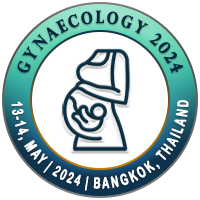
Rajshree Gohadkar
Rajdeep Fertility and Research Center, IndiaTitle: Minimally invasive surgical options for congenital and acquired uterine factors associated with mid trimester abortions
Abstract
Introduction: Recurrent mid trimester abortions is a devastating problem for couples desiring parenthood, it is often frustating and confusing clinical challenge for treating gynaecologist. Recurrent pregnancy loss occurs in 2 to 4 % of all reproductive aged couples. Mid trimester abortion constitutes 10 – 15% of all induced abortion. Second trimester or mid trimester is a period ranging from13 to 28 weeks of gestation which again is subdivided in to an early between 13 to 20weeks & late between 20 to 28 weeks. According to American society for reproductive medicine(asrm) the definition- recurrent pregnancy is as a distinct disorder with 2 or more failed clinical pregnancies before 20 weeks of gestation. Women with recurrent pregnancy loss have a 3.2 to 6.9% likehood of having major uterine anamoly. Uterine malformations are common and may contribute to adverse pregnancy outcome. After the accurate diagnosis by hystero-laparoscopy correcting the abnormal uterine morphology is the main goal to optimize reproductive out comes.
Aims and Objectives: To determine the frequency of different structural anomalies in patients with recurrent mid trimester abortions. First diagnose with Hystero-Laparoscopy & their minimally invasive treatment modalities. Inclusion criteria - women with 2 or more consecutive spontaneous easy mid trimester abortions (12 -20 weeks) Exclusion criteria - patients with established diagnosis of recurrent mid trimester abortions, autoimmune or genetic causes and pts. with medical illness were excluded.
Material and methods: This is an observational study conducted over a period of 4 years at Rajdeep Fertility and Research Centre, Kota between April 2019 to April 20023. Following second trimester miscarriage, a detailed gynaecological and medical history was taken with attention to gestational age at the time of loss, pelvic USG, HSG, blood was taken for full blood count, thyroid function, diabetes and autoimmune disease, anti phospholipid screening was done. All these patients underwent diagnostic sonography, H.S.G. & finally, diagnostic & therapeutic Hystero - Laparoscopy Strict criteria were used for cervical in competence, painless cervical dialatation resulting in ruptured membranes and expulsion of foetus, classically occuring in mid trimester. A total of 150 pts. were included in study suffering two or more mid- trimester abortions.
Results: According to Hystero- Laperoscopic findings congenital anamolies – septa , bicornuate , unicornuate , cervical incompetence were found in 80% . Acquired Anamolies in 20% cumulative live birth with or without surgery showed very higher chance of live birth after corrective surgery. Live birth rate is 90% in uterine septate uterus after surgery while in bicornuate and unicornuate after surgery preterm birth and low birth wt. is decreased. Pts. with cervical incompetence with failed previous mac-donald stich intraparturm were offered interval cervical circlage laparoscopically with almost 98% live birth in next Pregnancy.
Discussion: Uterine anomalies occur in about 19% of women with 2 or more consecutive miscarriages and are generally thought to cause miscarriage by interrupting the vasculature of the endometrium and prompting abnormal and inadequate placentation. Among women with mid trimester RPL septate uteri are the most prevalent of the congenital anomalies, as much as 76%. Diagnosis of congenital uterine anomalies is most accurately done with MRI or 3D USG. USG can show the contour of the uterine cavity but would not differentiate between septate and arcuate or bicornuate uteri. One review found that miscarriages rate of 86% among women with a septate uterus decreased to 16% following hysteroscopic correction. The primary treatment options for women with congenital uterine anomalies are surgical repairs. Septal resection has been reported to substantially reduce the rate of miscarriage in women with recurrent pregnancy loss. Majority of the uterine anomalies are amenable to correct by Minimally invasive surgical options that include hysteroscopic and laparoscopic resection & others. Intrauterine septa, polyps, adhesions and some fibroids can be operated hysteroscopically. Hysteroscopic resection of a septum or of adhesions is short surgical procedure that can be performed in most cases as out patient basis with normal return to activity. Hysteroscopic cavity enhancement in case of unicornuate uterus also improves the outcome in the form of full term pregnancy. Intrauterine adhesions typically form after endometrial trauma, often as a result of curettage following spontaneous abortions. Surgical removal of adhesions is usually recommended for RPL. Laparoscopic Adenomyoma resection will correct the uterine size & contour and by that improves outcome. Laparoscopic internal cervical encirclage is recommended in cases of mid trimester RPL with previous failed vaginal during pregnancy.
Conclusion: Anatomic abnormalities, both congenital and acquired account for 20% of the explainable causes of mid trimester recurrent pregnancy loss. Pregnancy rates are significantly improved after surgical correction. Diagnostic hysterolaparoscopy is an effective diagnostic and therapeutic modality for treatment in cases of mid trimester abortions.
Biography
Rajshree Gohadkar is highly qualified in M.B.B.S. (Bachelor of Medicine and Bachelor of Surgery) and has earned some very prestigious degrees through the career. She has got many years of training in Gynecologist Obstetrician Infertility IVF and valuable experience as a specialist in Reproductive Endocrinology & Infertility, Gynecology, Reproductive Endocrinology & Infertility, Obstetric & Gynecologic Surgery, Gynecologic Surgery, Reproductive Endocrinology & Infertility, Reproductive Endocrinology, Gynecologic Surgery, Obstetrics, Prenatal Care. She is the demanding and renowned doctor in Kota, Laparoscopic Surgeon specialist founded Rajdeep IVF Centre in Kota.

